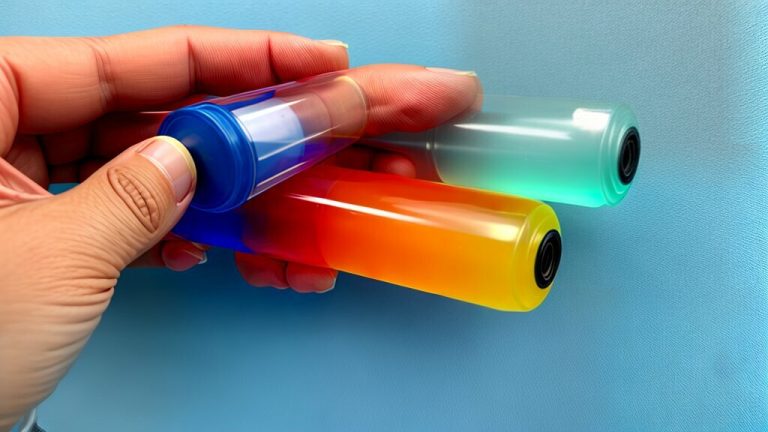What is the Difference Between Plasma and Serum? Explore Now
Plasma and serum are essential components of blood that play significant roles in various medical and scientific fields. While they may sound similar, they have distinct differences that are important to understand. This article will help you to understand the main difference between plasma and serum, their composition, collection, and processing, uses, and clinical significance. We will also highlight these components’ vital roles in the human body and discuss the factors that can affect their composition.
Our body requires serums internally and externally; this article explains the internal serum produced in our body; however, the external serum needs to be applied.
Key Takeaways:
- Plasma and serum are both essential components of blood that have distinct differences.
- Plasma is the liquid part of the blood that remains after the cells have been removed, while serum is the liquid part of blood which remains after the cells and clotting factors have been removed.
- The collection and processing methods for plasma and serum differ.
- Plasma and serum have different uses in various medical and scientific applications.
- Both plasma and serum play vital roles in the human body and can be affected by various factors, including age, diet, and medical conditions.
Understanding Plasma and Serum
Plasma and serum are two distinct components of blood, each with unique characteristics and functions. While they are similar in many ways, significant differences set them apart.
Plasma means the liquid portion of blood which remains after the blood cells, such as red and white blood cells and platelets that have been removed. It is a straw-colored fluid that makes up about 55% of total blood volume. Plasma comprises water, electrolytes, hormones, proteins, nutrients, and waste products.
Serum, on the other hand, is a type of fluid that remains after the blood has clotted and the clot has been removed. It is similar in composition to plasma but lacks fibrinogen, a protein involved in blood clotting. Serum accounts for about 40-45% of blood volume.
Distinguishing Plasma and Serum
The main difference between plasma and serum are their collection and processing methods. Plasma is obtained by drawing blood into an anticoagulant tube, preventing clotting and allowing the blood to remain liquid. Serum, on the other hand, is obtained by allowing the blood to clot in a tube and then separating the liquid portion from the solid clot.
Another important difference between plasma and serum is their use in diagnostic tests. Because it contains fibrinogen, plasma is used in many coagulation tests, whereas serum is used in tests which measure the levels of specific proteins and hormones.
Understanding the composition and variations of these two blood components is crucial for their appropriate use in various medical and scientific applications.
Composition of Plasma and Serum
While both plasma and serum are components of blood, their composition has significant differences. Plasma is a liquid portion of blood which contains all the blood clotting factors, while serum is the clear, yellowish fluid that remains after blood coagulation. They differ in their protein and mineral content as well.
| Plasma | Serum | |
|---|---|---|
| Protein Content | 6-8 g/dL | 6-8 g/dL |
| Clotting Factors | Yes | No |
| Fibrinogen | Present | Absent |
| Anticoagulants | Present | Absent |
| Electrolytes | Yes | Yes |
| Enzymes | Yes | Yes |
Plasma is rich in clotting factors, such as fibrinogen, and anticoagulants, that prevent the formation of clots. Serum, conversely, has no clotting factors or fibrinogen due to its formation after blood coagulation. Both plasma and serum have the same protein content, electrolytes, and enzymes.
Similarities and Differences Between Plasma and Serum
While the overall composition of plasma and serum is similar, differences exist in their protein and mineral concentrations and clotting ability. These differences impact their uses and laboratory processing methods. In the next section, we will discuss how these differences affect the collection and processing of plasma and serum.
Blood Collection and Processing
Blood collection and processing are crucial to obtaining plasma and serum, as they require different methods to preserve their composition and properties.
For plasma collection, blood is drawn into an anticoagulant tube to prevent clotting and centrifuged to separate it from the cellular components of blood. The resulting liquid is plasma, which can be further processed to separate proteins and other molecules for analysis.
| Plasma Collection | Serum Collection |
|---|---|
| Blood is collected into an anticoagulant tube | Blood is collected into a clotting-promoting tube |
| Centrifuged to separate plasma from cells | Left to clot and then centrifuged to separate serum from clot |
| Preserves coagulation factors and other plasma proteins | May alter some serum proteins and factors due to the clotting process |
Serum collection, on the other hand, involves drawing blood into a tube that promotes clotting, separating the liquid serum from the solid clot. Due to the clotting process, serum may lack some of the coagulation factors and other proteins typically found in plasma.
Blood Collection Techniques
Both plasma and serum can be collected using venipuncture, which involves the inserting of a needle into a vein and drawing blood into a collection tube. However, other techniques, such as fingerstick or heel-stick, may be used for small sample volumes or specific settings.
It is important to note that the analytical techniques used for plasma and serum may differ due to their distinct compositions and processing methods. Understanding these differences is critical to ensure accurate and reliable results in clinical and research settings.
Differences in Uses
While both plasma and serum are essential components of blood, they have different applications in medical and scientific contexts.
Plasma is used in various medical procedures, such as plasma transfusions for patients with blood clotting disorders or severe bleeding. Additionally, plasma is a crucial component in blood banks for transfusions and the manufacture of various blood products. Plasma is also used in research for studying the immune system, blood diseases, and drug metabolism and elimination.
Serum, on the other hand, is commonly used in diagnostic tests, such as measuring the levels of antibodies in the blood or detecting viruses and bacteria. The serum is also used for disease diagnosis and monitoring, such as monitoring levels of specific proteins that can indicate cancer or liver disease.
Understanding the different uses of plasma and serum is crucial for medical professionals and researchers alike in order to utilize these components and improve patient care appropriately.
Roles of Plasma in the Body
Plasma is a crucial blood component, making up about 55% of its total volume. As an extracellular fluid, plasma plays several essential roles in the body, such as:
- Transportation: Plasma helps transport essential nutrients, hormones, and proteins throughout the body. For example, plasma helps to carry oxygen from the lungs of the body to the tissues and carbon dioxide from the tissues of the body to the lungs for exhalation.
- Immunity: Plasma contains antibodies, complement proteins, and other immune cells that help protect the body against pathogens and foreign invaders.
- Coagulation: Plasma contains clotting factors that initiate and promote blood clotting, thereby preventing excessive bleeding in case of injury or trauma.
- Fluid Balance: Plasma helps maintain the body’s fluid balance and prevent edema (i.e., swelling) by regulating osmotic pressure and electrolyte concentrations.
These functions highlight plasma’s vital role in maintaining the body’s overall homeostasis and defending against diseases and infections.
Roles of Serum in the Body
In addition to plasma, the serum is a crucial component of human blood. Serum a the liquid that remains after blood has clotted and the clotting factors and cells have been removed. It contains various proteins, hormones, and other molecules which play an essential role in the various physiological processes.
One of the primary functions of serum is to transport various substances throughout the body. For example, the serum contains albumin, which helps transport hormones, fatty acids, and other substances through the bloodstream. Additionally, the serum includes globulins, a group of proteins that help transport ions, hormones, and other substances.
Serum also plays a vital role in the immune system. It contains antibodies, proteins that help protect the body against various foreign invaders like viruses and bacteria. When a foreign substance enters the body, antibodies in the serum help identify and neutralize it, preventing infection.
In addition, the serum contains complement proteins, which are part of the immune system’s defense against pathogens. The complement system can destroy invading microorganisms by punching holes in their cell membranes, making them more vulnerable to attack by immune cells.
Overall, a serum is an essential blood component that performs multiple vital bodily functions.
Clinical Significance
Both plasma and serum have significant clinical value and are used in various diagnostic and medical research contexts.
Plasma is often used in blood transfusions, as it contains vital clotting factors that can be helpful in treating bleeding disorders. Additionally, plasma can be used to diagnose autoimmune disorders, liver disease, and other medical conditions.
Serum, on the other hand, is commonly used in various diagnostic tests to detect the presence of specific antibodies in the blood, such as those associated with infectious diseases like HIV and hepatitis. Serum can also be used to monitor electrolyte levels and kidney function and diagnose various medical conditions.
The use of plasma and serum in medical research is also extensive, as they provide essential information about the body’s overall health and function. For example, plasma samples can be used to study how medications are metabolized in the body, while serum samples can provide valuable insights into the immune system and its functioning.
Overall, plasma and serum are essential components of many diagnostic and medical research procedures and are highly valued for their clinical significance.
Factors Affecting Plasma and Serum Composition
The compositions of plasma and serum may fluctuate depending on various factors. Researchers have identified different variables that may influence the chemical makeup of these two blood components.
Age: Age is one of the most significant factors that can impact plasma and serum composition. Studies have shown that the concentration of specific components in plasma and serum may change as one age. For example, the level of albumin, a protein that helps transport hormones and other substances, decreases with age.
Diet: Diet is another element that can alter plasma and serum composition. For instance, individuals who follow a plant-based diet may have higher levels of antioxidants in their blood compared to those who consume animal products.
Medical conditions: Certain medical conditions, such as diabetes or liver disease, can also affect the composition of plasma and serum. Individuals with these conditions may have higher levels of glucose or liver enzymes, respectively.
Medications: The medications an individual takes can also impact the composition of plasma and serum. Some drugs may increase or decrease the concentration of certain substances in the blood, leading to plasma and serum composition changes.
Understanding the various factors that can influence plasma and serum composition is essential for accurately interpreting diagnostic test results and conducting reliable research.
Analytical Techniques for Studying Plasma and Serum
Studying plasma and serum requires sophisticated analytical techniques to understand their composition and functions properly. Here are some of the most common methods used to study plasma and serum:
| Method | Description |
|---|---|
| Electrophoresis | A method used to separate proteins in plasma or serum based on their charge and size. This technique is commonly used to identify specific proteins and detect abnormalities in their levels. |
| Mass spectrometry | A technique used to identify and quantify the proteins in plasma and serum. Mass spectrometry provides high-resolution data and can identify a broad range of proteins. |
| Immunoassays | These assays use antibodies to detect and measure specific proteins in plasma or serum. They are commonly used in clinical settings to diagnose and monitor diseases. |
| Nuclear magnetic resonance (NMR) | NMR is a spectroscopic technique that can provide information on the structure and interaction of molecules in plasma and serum. This method is commonly used to study the structure of lipoproteins and other biomolecules. |
In addition to these techniques, several emerging technologies may hold promise for studying plasma and serum, including single-cell analysis, microfluidics, and proteomics. As technology advances, we can expect more significant insights into the composition and function of these vital components of blood.
Research and Future Directions
Research on plasma and serum continues to be a critical area of study in medical and scientific fields. As technology advances, new analytical techniques for studying these bodily fluids emerge, leading to discoveries and applications.
One area of ongoing research is the use of plasma and serum biomarkers for disease diagnosis and treatment. Researchers are exploring ways to identify and measure specific proteins or other molecules in these fluids that can serve as indicators of certain medical conditions. Such biomarkers could help doctors diagnose diseases earlier and more accurately.
Another area of research is the potential use of plasma and serum in regenerative medicine. Scientists are investigating how to use these fluids to stimulate tissue repair and regeneration, which could have significant implications for treating injuries and diseases.
Finally, researchers are working to understand better the factors influencing plasma and serum composition, such as diet and age. Understanding how these factors affect the fluids can improve diagnostic tests and treatments.
Conclusion
Plasma and serum are two crucial components of blood, and understanding their differences is essential in medical and scientific contexts. While both are similar in many ways, there are distinct variations in their composition and uses.
Plasma is the blood’s liquid part containing various proteins, electrolytes, and other essential nutrients. It is crucial in transporting these substances throughout the body and maintaining homeostasis. In contrast, a serum is a fluid that remains after clotting factors are removed from the plasma. It contains many proteins and nutrients as plasma but lacks clotting factors.
Both plasma and serum are used in diagnostic tests and medical research, and their composition that can be influenced by various factors, including age, diet, and medical conditions. Analytical techniques such as laboratory methods and technologies are used to study and analyze plasma and serum.
Future research in this field has the potential to lead to new advancements and applications, underscoring the importance of continued study of plasma and serum. In conclusion, understanding these differences and similarities between plasma and serum is essential in medical and scientific contexts, and continued research in this area holds great promise for the future.

I’m Carol Edwards, the force behind SerumDeals.com – your one-stop for all things serum. With over a decade of obsessing over skincare, I’m here to demystify sensational skin. I dig deep, testing serums in action. Beyond the surface, I uncover actual effectiveness. From ingredient breakdowns to real-life testing, my reviews are your trustworthy guide. Whether you’re a skincare rookie or diving into specifics like anti-aging or hydration, I’ve got your back with accurate info. Let’s simplify the serum journey together. SerumDeals.com isn’t just a site; it’s a hub for thriving skincare aficionados. Join me to uncover vibrant skin, one serum at a time.
Glowingly, Carol Edwards







